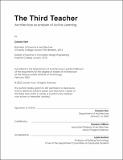The Third Teacher: Architecture as enabler of Active Learning
Author(s)
Tam, Carolyn
DownloadThesis PDF (44.35Mb)
Advisor
Clifford, Brandon
Terms of use
Metadata
Show full item recordAbstract
In the industrial age, schools were designed as tightly controlled environments to instill discipline and conformity to thrive in a machine era. Today, as architectural education evolves its mission away from manufacturing architects and towards producing creative contributors, the buildings that house education’s mission have remained stagnant - our learning environment is still rendered passive, utilitarian designs of the factory model, reinforcing the unhelpful boundaries between space and active learning.
This thesis challenges the manner in which architectural education works in pedagogy through the built form. Rather than fixing a same batch of learners in a rigid container, this thesis proposes a series of deployable systems that can adapt to various urban conditions to form dispersed learning environments. Learning is not separated from daily life - it could occur in a park, a vacant lot, or in the most unexpected of spaces – fostering diverse modes of learning and greater creative possibilities.
A key concept in active learning, which can extend to architecture, is wilderness education, where students are taken outside the classroom and use full-scale tools to create, play and test boundaries within their environments. This thesis asks, what if learning opportunities found in these instruments could be expanded to architecture. Architecture can be structural and systematic - but at the same time playful and engaging - and cross many disciplines, from geometry and surveying to physics and structure. Instructors and books are no longer the only teachers: the hands, the ears, the eyes, in fact, the whole body and the architectural space itself, become sources of information. Viewing students as active constructors of knowledge, the proposed architecture encourages students to use full-scale instruments and their context to engage with haptic, real-world learning experiences.
Date issued
2022-02Department
Massachusetts Institute of Technology. Department of ArchitecturePublisher
Massachusetts Institute of Technology